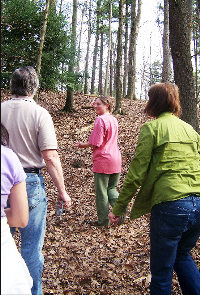About the Central Pennsylvania Mushroom Club (CPMC)
CPMC is dedicated to the study, protection, and enjoyment of wild mushrooms. It was formed in January 2010 to provide a forum for sharing reliable knowledge about the edible and inedible wild mushrooms that grow in central Pennsylvania. Our members include professional mycologists, expert and amateur collectors, enthusiastic chefs and mushroom-eaters, and many who just want to see, photograph, and enjoy the beautiful fungi that inhabit our abundant woodlands and parks. We are a totally electronic club and all official communications to members will be posted on this website or sent via the listserv.
CPMC is a 501 (c)(3) non-profit educational organization. Our mailing address is: Central Pennsylvania Mushroom Club, PO Box 450, Lemont, PA 16851. Information about how to join is given below. CPMC is a member club of NEMF, the NorthEast Mycological Federation, and an affiliate member of NAMA, the North American Mycological Association.

Some of the CPMC founding members at the first organizational meeting January 21, 2010
Membership and Dues
Who Can Join: Active membership is open to anyone of legal age (18 and above). All members must complete a membership application and sign a liability release form (see content below). Those who join after September 30 of a given year will be considered to be paid up until the end of the year following. Dues are $20 per year. Members who have not paid by the end of March will be dropped.
Content of Required Release Form: I, ______________________________________ , release the Central Pennsylvania Mushroom Club, its officers and members of any responsibility, liability or claim arising from any injury of any nature, purposeful or accidental incurred during or as a result of any club activity or event. This includes, but is not limited to, field trips, walks, forays, excursions, potlucks, edible mushroom gatherings, etc., that are sponsored by the Club.
How to Join: If you are legal age and want to join, download the membership application and follow the instructions on the form. Make checks payable to Central PA Mushroom Club and be sure to sign the release.
Download PDF Membership & Release Form
 Benefits of CPMC Membership
Benefits of CPMC Membership
- Mushroom walks through the season with one or more experts. Some walks will be for members only, (like spring morel hunts). Others will be open to all, but non-members will pay a fee.
- Participate in the club's e-mail list and get the inside scoop on what's going on in the local mushroom community such as what is fruiting and where.
- Meet and exchange information with other mushroomers and have access to our experts for help with mushroom identification
- Full access to members only area of this site
- Opportunity to attend one or more forays (see below) each year. These events are optional and have some associated cost.
- Free embroidered club patch and membership card.
- Access to club resources such as a microscope, test solutions, online teaching articles including mycological technique sheets, a copy of The Fifth Kingdom book on CD, and other articles. Please be aware that this resource is still in the early formative stages. Additional members will help expand our club resources.
 CPMC members receive a 10% discount at Appalachian Outdoors.
CPMC members receive a 10% discount at Appalachian Outdoors.
Frequently Asked Questions (FAQ)
Why do I need to sign a release form? Eating wild mushrooms can be hazardous. Some are deadly poisonous and others will make you very sick. Read this account by someone who ate a poisonous mushroom and survived (barely). In addition, some people have individual allergic reactions to fungi that most others eat with absolutely no problem. You need to realize and legally acknowledge that you and you alone are responsible for ultimately deciding whether or not to eat a particular mushroom. Therefore only individuals of legal age may join the club and all members must sign a form releasing the club and its executive committee from any liability of any kind. For members the release signed upon joining is binding as long as membership is active. Non-members must sign a release each time they take part in a CPMC sponsored event.
 Is it legal to pick mushrooms on state lands? Yes. The PA Conservation and Natural Resources Report, paragraph 11.211 (b) (1) clearly states that picking mushrooms in reasonable amounts for personal use is permitted. You may want to print this section of the report and carry it with you when you when you go collecting by yourself. It is at the bottom of page 11 and top of page 12.
Is it legal to pick mushrooms on state lands? Yes. The PA Conservation and Natural Resources Report, paragraph 11.211 (b) (1) clearly states that picking mushrooms in reasonable amounts for personal use is permitted. You may want to print this section of the report and carry it with you when you when you go collecting by yourself. It is at the bottom of page 11 and top of page 12.
About Our Mushrooming Activities
What's a mushroom walk? Either before or after a club meeting, we will take a mushroom walk during which a small group accompanied by one or more experts will search an area and collect fungi. A major part of a mushroom walk is to identify fungi and discuss other pertinent material such as habitat, look-alikes, distinguishing characteristics, etc. Identification may be made as finds occur and/or later when the group meets to exhibit and discuss what has been collected. Usually walks are not longer than 3-4 hours.
Then what's a foray? A foray is a much larger and longer event consisting on average of about 40 mushroom lovers, both professional and amateur, who get together for several days, usually over a weekend. They collect and then identify and discuss fungi and sometimes cook and consume their more choice edible finds. This year’s Second Annual Central PA Mushroom Foray was held August 13 -15 at Lock Haven University's Sieg Conference Center. If you want to know more about what went on, check Dave Robb's blog or tale a look at a slideshow.
Walk and Foray Guidelines
- Please do not hunt mushrooms for at least two weeks in an area where an event is planned. In order for these activities to be a good learning experience for all, we need to find fungi to identify and discuss. Obviously this cannot happen if folks have vacuumed up every mushroom in sight!
- If you are not a CPMC member, you must sign a release form or you will not be permitted to accompany the group.
- Children and minors must be accompanied by an adult who has legal authority to sign a release form.
- No dogs (or other non-human critters), please.
- Walks start on time. Please come early and socialize until it starts.
- Details about the terrain will be provided prior to the event. Make certain you are physically able to tolerate the conditions. Look for this information on the web page on the events and activities page.
What Should I Wear?
- Dress for the weather. Check a weather report for the activity area.
- Layering is a good idea and be prepared for rain.
- Suitable footwear is also important as the terrain may be rugged. You don’t want to sprain an ankle when you are out in the woods. Flip flops are NOT a good idea.
- Water and a snack are also wise—especially water.
What Should I Bring?
- Paper (never plastic) bags or waxed paper to separate different specimens and something to carry mushrooms in. Baskets, mesh bags, plastic planter trays or paper box lids will all work
- Other handy items: a knife, brush, hand lens, whistle, compass, insect repellent, and perhaps a guidebook.
- Depending upon the duration of the activity, you may want a kit with personal items (toilet paper, etc.) and a first aid supplies. Consider getting a tick removal kit (see below for more information).
Some Hazards of Mushroom Hunting
- Ticks that carry Lyme Disease are common in PA woods. There are several types of kits and tick removal gizmos, but avoiding the critters is best. Wear clothing that will help you see them easily. Tan, khaki or white are probably best, especially for gaiters, socks, pants, shirts, and hats. Even better is to keep the rascals off you altogether. Several over the counter products help a great deal: REPEL Sportsmen Max (with 40% DEET), REPEL Permanone Clothing & Gear repellent, SAWYER MAXIDEET(98.11% DEET), and OFF Deep Woods Sportsmen (98.11% DEET) are all favorites. See which of these or similar products works best and put it on before you head for the woods!
- Snakes - Yes, we do sometimes hunt mushrooms in snake country and usually we are preoccupied with looking for mushrooms, not snakes. This can lead to serious problems so, as with ticks, avoiding a bite is best. Snake gaiters are Kevlar wraparounds that cover your lower legs and even the biggest rattlesnake or copperhead cannot bite through them. One source is Cabelas, which often has them on sale. Depending on the color, they may help you see ticks on your lower leg, but whatever the color they will keep your lower pants and socks dry and help avoid briar scratches. Shown below (L) is a timber rattlesnake (Crotalus horridus). Copperheads (R) are also found in PA, but they are not nearly as common as rattlers. What to do if you encounter a snake (compliments of the Sierra Club).
.jpg)
.jpg)
.jpg)

- Poison ivy is found in many locations in Pennsylvania and senstive individuals should learn to identify this plant and stay clear of it. Watch where you are walking because even brushing against poison ivy will allow the toxic oil from the leaves to rub off on your shoes and clothing. The oil can remain active for quite a while and you may find yourself with a case of poison ivy from handling shoes or contaminated clothing. Wash exposed skin with cold water after you have been in the woods or after handling articles that might have touched poison ivy.
- Mushroomers need to realize that much of their foraging season overlaps with that of weapon-bearing hunters, who are not always as careful (or sober) as they ought to be. Consider wearing blaze orange hat and vest and make your presence known by making noise, talking, or the occasional toot on your whistle--especially during deer season in the fall. Spring brings turkey season until the end of May, but turkey hunters are a far less common hazard.
Looks like snakes love 'shrooms too!

| Attachment | Size |
|---|---|
| Application.pdf | 88.77 KB |
- Login to post comments
